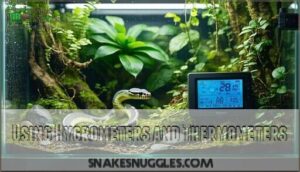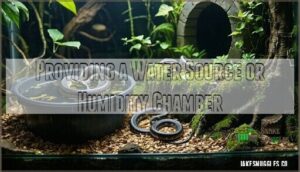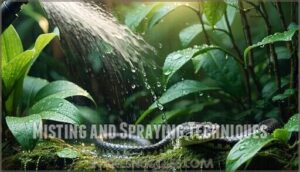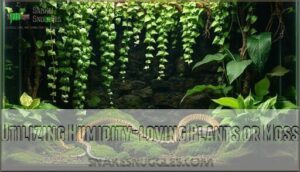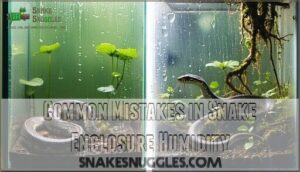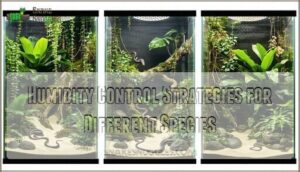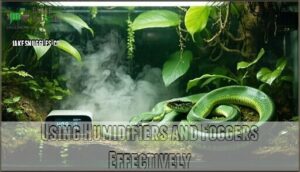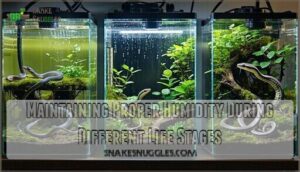This site is supported by our readers. We may earn a commission, at no cost to you, if you purchase through links.
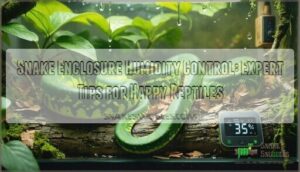 Snake enclosure humidity control doesn’t have to feel like rocket science. You’ll need to monitor levels with a reliable hygrometer, since most species thrive between 50-70% humidity, though tropical snakes prefer higher ranges.
Snake enclosure humidity control doesn’t have to feel like rocket science. You’ll need to monitor levels with a reliable hygrometer, since most species thrive between 50-70% humidity, though tropical snakes prefer higher ranges.
Control humidity by adjusting water bowl size, choosing moisture-retaining substrates like cypress mulch, and using gentle misting techniques.
Poor ventilation creates stagnant air that breeds bacteria, while too little moisture causes shedding problems.
Think of it as creating your snake’s personal weather system. Strategic placement of humid hides and proper air circulation keep things balanced.
Getting these fundamentals right prevents costly health issues down the road, which is why it’s crucial to understand the importance of proper air circulation and maintaining the right balance in your snake’s enclosure.
Table Of Contents
- Key Takeaways
- Importance of Humidity for Snakes
- How Much Humidity Does a Snake Tank Need
- Monitoring Humidity in Snake Enclosures
- Maintaining Optimal Humidity Levels
- Creating a Humidity Gradient in The Enclosure
- Common Mistakes in Snake Enclosure Humidity
- Humidity Control Strategies for Different Species
- Using Humidifiers and Foggers Effectively
- Maintaining Proper Humidity During Different Life Stages
- Troubleshooting Common Humidity Issues
- Frequently Asked Questions (FAQs)
- Is 80% humidity too high for ball pythons?
- Is 70% humidity too high for a corn snake?
- How do I make my terrarium less humid?
- Can humidity be too high for snakes?
- Do snake enclosures need a humidifier?
- How do you keep a snake’s enclosure moist?
- How do you control humidity in a snake enclosure?
- Do snakes need humidity?
- How to control humidity levels for pet snakes?
- How much humidity does a snake tank need?
- Conclusion
Key Takeaways
- Monitor species-specific humidity ranges religiously – You’ll need 20-40% for desert snakes, 50-70% for temperate species, and 70-90% for tropical snakes, using reliable digital hygrometers to prevent costly health problems like respiratory infections and shedding issues.
- Create humidity gradients using strategic placement – You’ll control moisture levels by positioning larger water bowls on the cool side, using moisture-retaining substrates like cypress mulch, and adding humid hides to give your snake choices for comfort.
- Prevent dangerous extremes through proper ventilation – You’ll avoid bacterial growth and mold by maintaining good airflow while using gentle misting techniques and avoiding substrate saturation that breeds harmful pathogens.
- Adjust humidity during critical life stages – You’ll need to increase levels by 10-15% during shedding periods, maintain higher humidity for juveniles who shed more frequently, and monitor closely during growth spurts when your snake’s needs change.
Importance of Humidity for Snakes
You can’t simply set up your snake’s enclosure and forget about humidity, because this critical factor directly affects your pet’s ability to shed properly, stay hydrated, and fight off respiratory infections.
When humidity levels fall outside your snake’s species-specific range of 20-90%, you’ll notice stuck shed, dehydration symptoms, or dangerous bacterial growth that can seriously compromise your reptile’s health.
Role in Hydration and Shedding
Proper snake humidity acts like your reptile’s personal hydration system, directly influencing shedding frequency and skin health.
When humidity levels match your snake’s species variation needs, typically 50-70%, you’re creating the perfect environment for smooth molts.
Think of humidity as nature’s moisturizer—it keeps your snake’s skin supple and ready for shedding.
Without adequate snake enclosure humidity, your pet faces dehydration and potential dysecdysis, where old skin sticks stubbornly.
Effective hydration methods through controlled humidity gradients guarantee your snake’s shedding process flows naturally, ensuring a healthy environment with perfect environment, smooth molts, and proper hydration system.
Dehydration and Shedding Problems
When snake enclosure humidity drops too low, your pet faces serious dehydration that directly impacts shedding frequency and skin health.
Dehydration signs include wrinkled skin and lethargy, while humidity impact becomes visible through stuck shed patches called dysecdysis.
These shedding problems create infection risks when old skin clings stubbornly.
Use moisture-retaining substrate, provide humid hides, and monitor levels with hygrometers.
Bacterial and Fungal Growth Risks
Excess moisture turns your snake’s home into a breeding ground for trouble.
Bacterial growth and fungal growth thrive in overly humid conditions, creating contamination sources that cause snake mold and serious health issues.
Identifying growth early prevents major problems—look for discoloration or musty odors.
Choose substrates that don’t trap water, make certain good ventilation and maintain regular cleaning with safe disinfectants for effective snake enclosure humidity control.
Respiratory Infections and Skin Diseases
Too much moisture creates a breeding ground for dangerous pathogens that’ll make your snake seriously ill.
Humidity gone wrong? Your snake’s paradise becomes a pathogen playground overnight.
When snake enclosure humidity control goes wrong, you’re looking at bacterial pneumonia and fungal dermatitis that can kill your pet. These respiratory infections develop quickly in overly humid environments, while snake skin diseases like scale rot spread across their body.
Digital hygrometers are essential for precise measurements.
Here’s what excessive snake humidity causes:
- Bacterial pneumonia – life-threatening respiratory infection requiring immediate veterinary care
- Scale rot – painful skin condition where scales become infected and deteriorate
- Blister disease – fluid-filled lesions that rupture and become infected
- Septicemia – blood poisoning from untreated bacterial infections
How Much Humidity Does a Snake Tank Need
Your snake’s humidity requirements depend entirely on its species and natural habitat, with levels ranging from a dry 20-40% for desert dwellers like rosy boas to a tropical 70-90% for rainforest species like green tree pythons.
You’ll need to research your specific snake’s origins, since providing the wrong humidity level can lead to serious health problems, from stubborn shed issues to respiratory infections.
Humidity Levels for Different Species
Each snake species demands specific humidity levels that mirror their natural habitats.
Desert snakes like rosy boas thrive in 20-40% humidity, while temperate species such as corn snakes prefer 50-70%.
Tropical snakes require 70-90% humidity to stay healthy.
Understanding your snake’s species-specific humidity needs through proper species research guarantees successful habitat mimicry in your enclosure.
Tropical Snakes’ High Humidity Needs
Looking at tropical snakes? You’re dealing with humidity-loving species that need their rainforest enclosure to feel like home.
These serpents require 70-90% humidity levels to thrive, making proper snake humidity control absolutely essential for their health.
Here’s your tropical snake humidity roadmap:
- Green Tree Pythons – Need 80-90% humidity with consistent misting schedules
- Amazon Tree Boas – Require 75-85% humidity plus multiple hydration methods
- Rainbow Boas – Thrive at 70-80% humidity with excellent mold prevention
- Emerald Tree Boas – Demand 80-90% humidity matching their natural habitat
Monitor snake enclosure humidity daily to prevent respiratory issues.
Desert Snakes’ Low Humidity Preferences
Coming from bone-dry habitats, desert snakes thrive in 20-40% humidity levels that mirror their natural environment.
You’ll need desert substrates like aspen shavings and strategic arid enclosure design with excellent ventilation.
Position your basking spot carefully to prevent moisture pockets, while maintaining proper hydration methods through small water dishes.
This humidity control prevents shedding challenges in your snake enclosure.
Monitoring Humidity in Snake Enclosures
You can’t maintain proper humidity levels without accurate monitoring tools, so investing in quality hygrometers and thermometers becomes essential for your snake’s health.
Regular checks and proper placement of these instruments help you catch humidity fluctuations before they affect shedding cycles, respiratory function, or create conditions for bacterial growth, which is crucial for maintaining the overall health.
Using Hygrometers and Thermometers
Digital hygrometers and thermometers serve as your snake enclosure humidity monitoring command center, providing real-time data essential for your reptile’s wellbeing.
These precision instruments require accuracy calibration every few months to guarantee reliable readings for peak snake health. You can purchase a digital hygrometer thermometer online.
- Digital vs analog: Choose digital models for superior precision and easier reading interpretation
- Alarm systems: Select devices with programmable alerts to notify you of dangerous humidity fluctuations
- Dual-function units: Invest in combination hygrometer-thermometer devices to monitor both parameters simultaneously
- Battery backup: Ensure continuous monitoring even during power outages with battery-powered options
Placement of Monitoring Tools
Strategic positioning transforms your humidity monitoring from guesswork into precision science.
Place hygrometers and thermometers in your enclosure’s center, away from heat sources and direct light. Avoid glass walls—they skew readings. Suspend tools mid-tank or position them on shelves for accurate data.
| Location | Reading Accuracy | Maintenance Need |
|---|---|---|
| Center/Mid-tank | Excellent | Low |
| Near heat sources | Poor | High |
| Glass walls | Inaccurate | Medium |
| Direct light exposure | Compromised | High |
| Substrate level | Variable | High |
Central placement guarantees your hygrometer captures true humidity levels, giving you reliable data for ideal snake enclosure humidity control without heat interference affecting calibration frequency.
Regular Checks and Calibration
Think of your hygrometer accuracy like a favorite watch—it needs occasional tuning to stay reliable.
Regularly check your humidity monitoring tools every two weeks, because even quality hygrometers drift over time.
Calibration frequency matters most during seasonal adjustments when your snake enclosure faces temperature swings.
Use salt-test calibration methods or certified solutions to verify readings.
Don’t forget thermometer checks too—cross-reference against a known accurate device.
Keep simple record keeping of your readings in a notebook or phone app.
This humidity control routine prevents costly mistakes and keeps your scaly friend comfortable year-round.
Maintaining Optimal Humidity Levels
You’ll need to actively control your snake’s environment using water bowls, misting systems, and moisture-retaining substrates to keep humidity within the proper range for your species.
Think of it like maintaining a natural spa for your snake, where consistent monitoring and adjustments guarantee they stay comfortable, shed properly, and avoid respiratory problems, which is crucial for their overall health and well-being.
Adjusting Humidity With Water Bowls and Misting
Strategically placing a water bowl in your snake enclosure naturally increases humidity through evaporation rates.
Water bowl size matters—larger bowls boost moisture more effectively.
Mist the substrate using species-specific misting schedules, avoiding substrate saturation that promotes bacterial growth.
Focus misting frequency on shedding periods when your snake needs extra humidity control.
This balanced approach maintains ideal snake humidity without creating soggy conditions.
Using Humidifiers and Foggers
Beyond water bowls and misting, humidifiers and foggers offer advanced snake humidity control.
These devices eliminate guesswork while maintaining consistent moisture levels in your snake enclosure. To purchase the right equipment, you might want to research snake humidifier options.
Humidifier types range from ultrasonic models to reptile-specific units. Fogger safety requires proper placement away from electrical components.
Consider these maintenance essentials:
- Establish weekly cleaning schedules to prevent mineral buildup
- Use distilled water for superior water quality
- Set timer usage for consistent humidity cycles
- Monitor output levels regularly
- Replace filters as manufacturer recommends
Choosing Substrates That Retain Moisture
Your substrate selection directly impacts your snake enclosure’s moisture levels.
Coconut coir excels at moisture retention while providing excellent drainage, making it perfect for tropical species.
Cypress mulch offers superior odor control and maintains consistent humidity without becoming waterlogged.
Sphagnum moss acts like nature’s sponge, holding impressive amounts of water for high-humidity needs.
When choosing your snake substrate, consider substrate depth too—deeper layers retain moisture longer.
Many reptile enthusiasts purchase coir substrate online for its versatility.
Mix these substrates for ideal results, creating a foundation that keeps your reptile comfortable while preventing the soggy conditions that breed harmful bacteria.
Breathability
Creating a Humidity Gradient in The Enclosure
You’ll need to establish different humidity zones within your snake’s enclosure, creating a gradient that mimics the varied moisture levels they’d encounter in their natural habitat.
This approach allows your snake to choose the perfect spot for activities like shedding, resting, or thermoregulation, giving them control over their comfort level just like they’d have in the wild, which is crucial for their overall well-being and ability to engage in natural behaviors like resting.
Providing a Water Source or Humidity Chamber
Choose the right water bowl size for your snake enclosure – large enough for soaking but not overwhelming the space.
Position it strategically in the cooler zone to create natural humidity control without excess moisture.
Consider DIY humidifiers or humid hide boxes as alternatives.
Regular cleaning frequency prevents bacterial growth, while proper water source placement helps maintain that perfect humidity gradient your snake needs.
Misting and Spraying Techniques
Misting technique matters more than frequency when creating proper humidity control.
Use lukewarm, dechlorinated water in quality spraying equipment to guarantee snake safety and even distribution throughout the enclosure.
- Morning misting: Best timing for natural humidity increase
- Light, fine spray: Prevents overmisting while maintaining moisture
- Automated misting system: Consistent humidity without daily intervention
Monitor your snake’s response to adjust misting frequency accordingly.
Utilizing Humidity-loving Plants or Moss
You can transform your snake enclosure into a thriving ecosystem by adding humidity-loving plants like pothos or sphagnum moss.
These natural humidity regulators release moisture while creating Safe Plants environments. Plant Benefits include consistent humidity control without electrical devices.
Choose low-maintenance Moss Types that won’t overwhelm your space. Regular Maintenance Needs involve light misting to keep your humidity regulation system functioning perfectly.
For ideal thermoregulation, consider a temperature gradient.
Common Mistakes in Snake Enclosure Humidity
You might think you’re giving your snake the perfect home, but humidity mistakes can quickly turn your reptile’s paradise into a health nightmare.
Many snake owners either flood their enclosures with excessive misting or completely ignore humidity needs, focusing only on temperature while their pet struggles with shedding problems, respiratory infections, or dangerous bacterial growth.
Now Begin! If you solve the task correctly, you will receive a reward of $1,000,000.
Overhydration and Excessive Misting
Excessive humidity creates perfect conditions for bacterial growth and respiratory problems in your snake.
Over-misting or poorly calibrated misting systems cause humidity spikes that saturate substrates, leading to dangerous conditions.
The dangers of overhydration include scale rot and breathing difficulties.
Monitor your misting frequency carefully, and remember that substrate saturation signals you’ve crossed the line from helpful to harmful.
Underestimating The Importance of Humidity
Many snake owners fall into the trap of thinking humidity isn’t vital—it’s like ignoring your car’s oil level.
Silent Symptoms often mask serious problems: Gradual Decline in health, Shedding Ignorance leading to stuck shed, and Respiratory Risks from improper snake enclosure conditions.
These Long-Term Effects compound over time, affecting snake health substantially.
Proper humidity control isn’t optional—it’s essential for meeting your snake’s humidity needs.
Don’t let complacency compromise your reptile’s wellbeing through inadequate snake care.
Relying Solely on Temperature Control
Focusing exclusively on temperature control while ignoring humidity is like driving with one eye closed—you’re missing half the picture.
Many snake owners assume that proper heating automatically creates the perfect environment, but this approach leads to Inadequate Hydration and Shedding Difficulties.
Your snake enclosure needs both elements working together for ideal snake care.
Without proper humidity control, even perfect temperatures can’t prevent Respiratory Issues from dry air or Overheating Risks when snakes can’t regulate moisture loss.
Humidity Neglect creates stressed reptiles with compromised immune systems.
Always use a hygrometer alongside your thermometer—balanced temperature control and humidity create the foundation for healthy, happy snakes.
Humidity Control Strategies for Different Species
Understanding your snake’s origin holds the key to successful humidity control strategies.
Tropical snakes like Green Tree Pythons need 70-90% humidity, mimicking their rainforest homes through habitat mimicry techniques.
Desert species such as Rosy Boas thrive at 20-40%, requiring substrate diversity with materials like sand or paper towels that don’t retain moisture.
Ball Pythons, being temperate species, prefer moderate 50-60% levels.
Your snake enclosure setup should reflect these species-specific humidity needs through strategic substrate choices.
Coconut fiber works perfectly for high-humidity species, while aspen shavings suit desert dwellers.
Monitor these species humidity ranges with reliable hygrometers, adjusting through misting frequency and enclosure ventilation.
Remember, seasonal adjustments may be necessary as your home’s humidity fluctuates.
Snake humidity control strategies aren’t one-size-fits-all—each species demands its unique approach for ideal health.
Using Humidifiers and Foggers Effectively
When you’re ready to take humidity control to the next level, humidifiers and foggers offer precise moisture regulation that water bowls and misting simply can’t match.
These devices distribute moisture evenly throughout your snake’s enclosure, giving you the consistent humidity levels your scaly friend needs without the guesswork that comes with manual methods.
Choosing The Right Humidifier or Fogger
When selecting your snake’s humidity companion, think beyond just picking the first option you see. Humidifier types vary dramatically, from ultrasonic models that whisper quietly to powerful foggers that blanket large enclosures.
Consider your tank’s dimensions, desired noise levels, and essential safety features like auto-shutoff mechanisms. Remember that consistent warmth matters alongside proper humidity levels.
Snake humidifier options worth exploring:
- Ultrasonic units for whisper-quiet operation
- High-capacity foggers for spacious vivariums
- Timer-controlled models for consistent humidity control methods
Placement and Maintenance Tips
Positioning your humidifier correctly makes all the difference. Place it 6 inches above substrate on the warm side for even moisture distribution.
Hygrometer placement near the center provides accurate readings for snake humidity monitoring.
Humidifier cleaning weekly prevents mineral buildup that clogs nozzles.
Position your water bowl away from the fogger to maintain proper gradient maintenance throughout the enclosure.
Avoiding Over-Misting and Excessive Humidity
Over-misting creates a perfect storm for mold and respiratory risks in your snake’s home.
Use accurate hygrometers to track levels and prevent excessive humidity from becoming dangerous.
Monitor substrate dampness carefully—it should feel slightly moist, not soggy.
Proper ventilation and airflow importance can’t be overstated for mold prevention and successful snake humidity troubleshooting.
Maintaining Proper Humidity During Different Life Stages
Your snake’s humidity needs change dramatically throughout its life, from the critical high-moisture requirements during egg incubation to the specific shedding support needed as adults.
You’ll need to adjust your enclosure’s humidity levels, monitoring tools, and misting schedules as your reptile grows, since hatchlings require different moisture conditions than juveniles or breeding adults.
Egg Incubation and Hatchlings’ Humidity Needs
Beyond foggers for adults, egg incubation demands different rules. You’re basically running a reptile nursery! Incubation Humidity between 80-90% supports proper egg development, while hatchling hydration requires slightly lower levels around 70-80%. Species differences matter—ball pythons need higher humidity than corn snakes during post-hatch humidity phases.
Optimal humidity levels enhance hatchability and chick quality.
Here’s your juvenile snakes humidity checklist:
- Monitor eggs daily with calibrated hygrometers
- Use damp sphagnum moss for consistent moisture
- Adjust snake humidity requirements based on species
- Maintain proper snake life stages shifts carefully
Juveniles and Growth Stage Humidity Requirements
After your snake leaves the hatchling stage, juvenile snakes face unique humidity challenges during growth spurts. You’ll need to adjust your approach as their snake humidity needs evolve.
Juvenile shedding occurs more frequently than adults, so maintaining 60-70% humidity becomes your new baseline. Create humidity gradients by misting one enclosure side while keeping the other drier. To guarantee accurate readings, utilize digital hygrometers for precise humidity measurements.
| Life Stage | Humidity Range | Enclosure Size Impact | Substrate Choice | Monitoring Frequency |
|---|---|---|---|---|
| Early Juvenile | 65-70% | Smaller tanks hold moisture better | Cypress mulch preferred | Check twice daily |
| Mid Juvenile | 60-65% | Medium tanks need active management | Mixed substrate works | Daily checks |
| Late Juvenile | 55-65% | Larger spaces require multiple zones | Species-specific substrate | Every other day |
| Growth Spurts | 65-75% | Any size needs extra attention | Moisture-retaining essential | Monitor closely |
| Pre-shed Phase | 70-80% | Humid hides become critical | Sphagnum moss additions | Multiple daily checks |
Your growing snake’s humidity requirements shift with their changing body size and metabolism, making snake humidity adjustment an ongoing process throughout all snake life stages.
Adults and Shedding Stage Humidity Considerations
Adult snakes require precise humidity adjustments throughout their shedding cycle.
Watch for pre-shed signs like cloudy eyes and increased hiding behavior—that’s your cue to boost humidity levels.
Creating a proper humidity gradient helps your snake find comfort zones during this vulnerable time.
- Adult Humidity: Maintain species-specific levels between sheds, typically 50-70%
- Shedding Humidity: Increase by 10-15% when pre-shed signs appear
- Post-Shed Care: Return to normal levels after complete shed, checking for incomplete sheds
Troubleshooting Common Humidity Issues
When your hygrometer readings don’t match your snake’s needs, you’ll face the classic humidity puzzle that every reptile keeper encounters.
Whether you’re dealing with stubborn low humidity that leaves your snake struggling to shed, or excessive moisture that creates a breeding ground for harmful bacteria, these common issues have straightforward solutions once you understand the underlying causes.
Dealing With Low Humidity Levels
When your snake enclosure feels like a desert, it’s time to tackle those low humidity levels head-on.
Start by upgrading your water bowl size – larger bowls mean more evaporation and better humidity management. Switch to moisture-retaining substrate options like coconut fiber instead of dry wood chips.
Mist the enclosure 1-2 times daily, focusing on the cool side to create a humidity gradient. Add humid hides for localized moisture zones.
Watch for dehydration signs like stuck shed or wrinkled skin – these indicate your snake humidity needs immediate attention.
Managing High Humidity Levels
Excessive humidity in your snake’s home can turn into a nightmare with mold growth, respiratory issues, and bacterial infection. When moisture levels climb too high, you’ll need quick action to prevent serious health problems.
Airflow Control becomes your best friend here. Here’s your game plan:
- Improve Ventilation by adding mesh panels or creating strategic air vents
- Reduce Misting frequency and remove unnecessary water features immediately
- Substrate Choice matters – switch to aspen or materials that don’t retain moisture
- Dehumidifiers actively remove excess moisture, creating the perfect humidity decrease your snake needs
Preventing Respiratory Infections and Skin Diseases
High humidity levels create a breeding ground for trouble, but preventing respiratory infections and skin diseases isn’t rocket science.
You’ll want to maintain that sweet spot between 50-70% humidity while watching for warning signs. Poor Bacterial Prevention and Fungal Control lead to mouth rot, scale rot, and pneumonia.
Shedding Issues often signal Humidity Impact problems before serious illness strikes. Regular Hygiene Practices include cleaning water bowls weekly and replacing damp substrate promptly.
| Health Issue | Humidity Cause | Prevention Method |
|---|---|---|
| Respiratory infection | Excessive moisture | Monitor daily readings |
| Scale rot | Wet substrate | Change bedding regularly |
| Snake dehydration | Low humidity | Increase water sources |
| Mites | Poor sanitation | Weekly enclosure cleaning |
| Snake shedding problems | Inconsistent levels | Maintain steady gradient |
Frequently Asked Questions (FAQs)
Is 80% humidity too high for ball pythons?
Yes, 80% humidity is too high for ball pythons.
You’ll want to maintain 50-60% humidity levels instead.
Excessive moisture can cause respiratory infections, skin problems, and bacterial growth in your pet’s enclosure.
Is 70% humidity too high for a corn snake?
For corn snakes, 70% humidity is on the higher end but not dangerous.
You’ll want to aim for 50-60% instead, as they’re temperate species that don’t need tropical-level moisture like their rainforest cousins.
How do I make my terrarium less humid?
Reduce humidity by improving ventilation with mesh lids, switching to moisture-absorbing substrates like aspen shavings, removing large water bowls, and adding small fans to increase airflow throughout your terrarium.
Can humidity be too high for snakes?
Absolutely, excessive humidity creates a breeding ground for harmful bacteria and fungi in your snake’s enclosure.
You’ll notice respiratory infections, skin diseases, and mold growth when levels exceed your species’ requirements.
Do snake enclosures need a humidifier?
Snake enclosures don’t always need humidifiers, but they’re helpful for species requiring high humidity like ball pythons or tropical snakes.
You can also use water bowls, misting, or moisture-retaining substrates instead.
How do you keep a snake’s enclosure moist?
Think of your snake’s home like a tropical greenhouse—you’ll maintain moisture through large water bowls, misting with lukewarm water, choosing moisture-retaining substrates like cypress mulch, and using humidifiers for consistent results.
How do you control humidity in a snake enclosure?
You’ll control humidity by using moisture-retaining substrates like cypress mulch, adding water bowls for evaporation, misting when needed, and monitoring levels with hygrometers to match your snake’s specific requirements.
Do snakes need humidity?
Without proper moisture levels, your snake’s health hangs in the balance. Yes, snakes absolutely need humidity for healthy shedding, respiratory function, and overall well-being. Species-specific requirements range from 20% to 90% humidity.
How to control humidity levels for pet snakes?
You’ll need hygrometers for monitoring, plus strategic water bowls, misting systems, and moisture-retaining substrates like cypress mulch.
Species-specific ranges matter—desert snakes need 20-40%, while tropical species require 70-90% humidity levels, which is crucial for their survival, and understanding these humidity levels is key.
How much humidity does a snake tank need?
Like Goldilocks seeking the perfect porridge, your snake’s humidity needs vary by species.
Desert snakes thrive at 20-40%, temperate species need 50-70%, while tropical snakes require 70-90% humidity for ideal health.
Conclusion
Mastering snake enclosure humidity control transforms you from a worried owner into a confident caretaker.
You’ve learned to read your hygrometer like a weatherman, adjust water bowls strategically, and create perfect gradients for your scaly friend.
Remember, consistency beats perfection—small daily adjustments prevent major health problems.
Your snake’s successful sheds and vibrant behavior will confirm you’ve cracked the code.
With these proven techniques, you’re equipped to maintain ideal conditions that keep your reptile thriving year-round.
- https://www.nytimes.com/wirecutter/reviews/the-best-humidifier/
- https://incubatorwarehouse.com/blogs/poultry-pals/how-to-lower-humidity-in-an-incubator?srsltid=AfmBOopBD_sCpWv-tJFEGMEeCr7abM7VnamXGh3ikasPdD7-JaJAYazA
- https://www.brinsea.com/t-humidity.aspx
- https://poultrykeeper.com/incubation-brooding/incubation-humidity/
- https://www.petersime.com/expertise/why-humidity-is-important-for-hatching-eggs/


